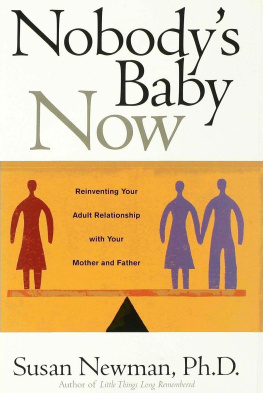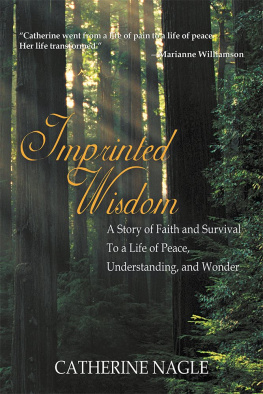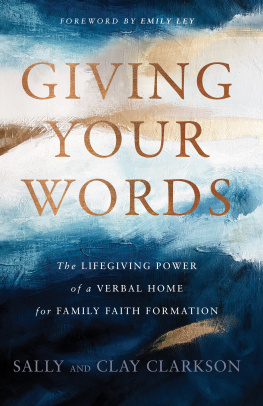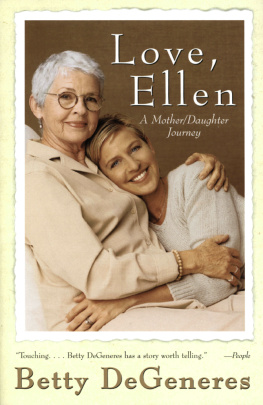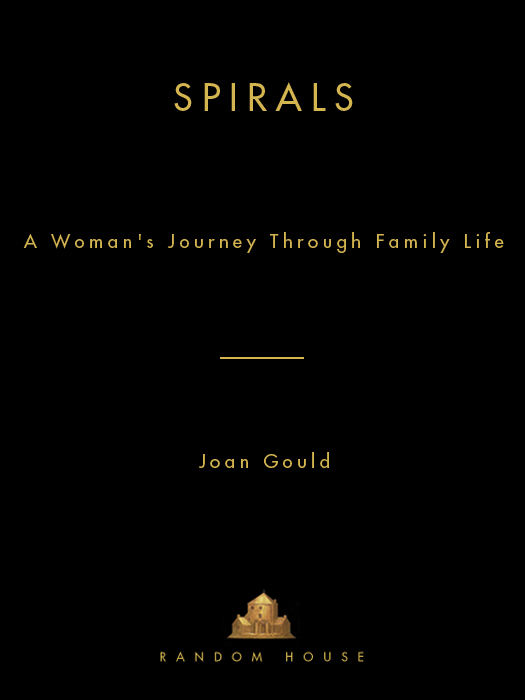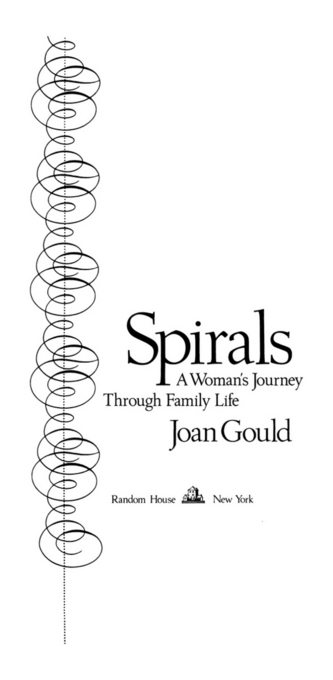Copyright 1988 by Joan Gould
All rights reserved under International and Pan-American Copyright Conventions. Published in the United States by Random House, Inc., New York, and simultaneously in Canada by Random House of Canada Limited, Toronto.
Library of Congress Cataloging-in-Publcication Data
Gould, Joan, 1927
Spirals / by Joan Gould.
p. cm.
eISBN: 978-0-307-82645-9
1. WomenPsychology. 2. Life cycle, Human. 3. WidowsPsychology. 4. Mothers and daughters.
I . Title.
HQ 1206. G 72 1988
155.633dc19 87-28352
v3.1
Contents
Introduction
Family. Familiar. Only my family isnt familiar at all. My friends are familiar, my friends are as dependable as telephone poles, but the members of my family change in size, looks, powers, burdens and expectations, when all I ask of them is that they remain the same.
Children grow, gather power while their parents lose it, leave home, travel in other orbits. Parents move, remarry or dont remarry, dwindle away, die. Spouses may stay around for a long whilemine did, for twenty-eight yearsbut sooner or later they leave.
And I keep changing too, even though Im the one who stays home. I picture myself in the role of mother, particularly the mother of young children, because this is a self I likedistracted and short-tempered, I grant you, but well-meaning in spite of outbursts. Still, I have to recognize that this is different from the self who was a daughter or wifeand these dont have much in common with the new, apprentice selves, who have to learn a whole set of limits, as mother of adults, mother-in-law, widow and grandmother. One thing these selves have in common, however: Theyre not the same as my self when Im alone.
This book, which is fact, not fiction, is based on a journal that Ive kept for years. I havent invented anything except a few background details about people who arent members of the family, in order to protect their privacy, and false names for everyone involved except my husband, Martin, and our collie, Ralph. Those two dont admit displacement. I couldnt think of either of them under another name, and, as it happens, neither of them is in a position to object.
A few months after I began keeping the journal, Martin became fatally ill, which raised a series of questions: Should I tell him the truth about his conditionin other words, does truth have some virtue that imposes obligations of its own? If he knew the truth, would he stop working, and if so, what would such a decision say about the way hed spent his life up to that point? Most important for me, how was I going to survive without him?
I meant that question in the literal sense. Until the day I was married, I saw myself as a daughter opposed to my mother. After that day, I saw myself united with Martin and then as the mother of three children, but now I was about to lose not only my husband but my job. Two of my childrenTed and Karenwere already grown-up; Ted was married, and Karen was as-good-as-married, which her father and I considered not-quite-as-good. Peter, our youngest, who was born sixteen years almost to the day after his older brother, was ten years old at this point, so that not even he would need me much longer. I was about to become either the whole of my own life or nothing at all.
Two years after Martins death, when I started this book, I planned to write about my husband and children, and about myself as a wife and mother. But thats not the book that Ive written. Instead, Ive concentrated on the one subject that I didnt want to touch, which shows what exotic and dangerous territory we cross as soon as we venture into the subject of family. Id forgotten that I was a daughter, after all, long before I was a wife, and whats more, I continued to be a daughter after Martin was gone. The only question was, what sort of daughter was I?
My mother had never liked me, I was sure of that, or at the very least, shed never approved of me. Wed never spent a peaceful afternoon together. How was I to deal with someone I might love but didnt necessarily likein particular, how was I going to deal with her impending death? I couldnt simply distance myself, as Id done in the past. The bond between us was real. If she died while I was unable to mourn for her, I felt that I would wipe out her existence as a mother (shed never been much of a mother, or anything else, for that matter, except too much of a daughter), while at the same time I would diminish my own life in a way I couldnt yet understand.
This problem bedeviled me so thoroughly that I wasnt able to finish the book until Id resolved it. For all I know, it may have been the reason why I undertook to write the book in the first place. At last, to my astonishment, a time came when I simply stopped agonizing about our relationship and realized that on a more significant level, it didnt matter whether my mother and I liked or even loved each other or not; there was a deeper bond than liking or not-liking between us. A child needs parents to give him life and to nurture himbut a father or mother has an equally urgent need for a child to complete the parents life and give him a proper death, through the consummate act of seeing him whole. When I was able to see my mother whole, I was able to finish this book.
Birth, when I looked straight at it, seemed as tangled with problems as death. Why should a mother love the particular lump of flesh thats handed to her in her hospital room? I asked myself. Later my question became even sharper: Can a grandmother honestly claim to love an infant seen behind glass in a hospital nursery if she doesnt know which infant shes supposed to love without reading the name on the index card? Would we need all those bibs with Grandma Loves Me embroidered on them, if our responses were so predictable?
Writing a book about family means writing a book about time, I discovered, since time is the dimension that families live in, but friends and lovers lack. (If friends and lovers stick with us long enough for us to perceive changes in them and for them to perceive changes in us, why then, according to my definition, they are not just friends and lovers any more; they are transformed into family.) But what shape is time? An image floated into my head, and this image became not only the title but the shape of the book.
When I was young, I assumed that time had to be a straight line, like a railroad track that would carry me from the past into the future: from school to career, from marriage to parenthood, at which point it would become a double track, heading up as long as my husband and I were hardworking and lucky, running downhill or staying level for certain stretches, of course, but sloping up in general, up and up, until Why, until the day came when the line didnt head up any more. Until the day came when it headed down much more abruptly than it had headed up. But that was a day that no one chose to talk about, wives least of all.
The only alternative Id heard of was a circle, which was the usual picture of marriage for women in the 1950s: the family circle, safe as lamplight and sure as the seasons; the daily grind of the kitchen cleaned up tonight so that it can get dirty tomorrow; groceries carried into the house and garbage carried out in the saved paper bags; the wheel of time spinning and spinning but getting me nowhere.
I dreaded the circle, but had no need to worry. True enough, events in my life seem to twist on their tails and come back at me again, but theyre never quite the same; theyve changed in the interval, and so have I. (If they didnt change, if my life were really a circle, I might learn more from experience and do everything better the second or tenth time round.)



